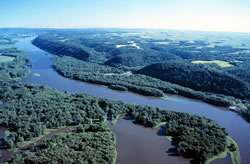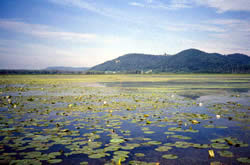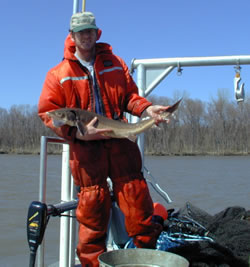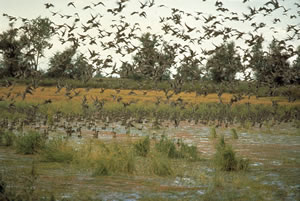The Importance of Off-Channel Areas to Fish Production
The Importance of Deep Channels to the Production of Riverine Fishes
Managing Pathways of Biological Production in Large-River Ecosystems
|
Biological production represents the total amount of living material (biomass) that was produced during a defined period of time. This production is important because some of it is used for food and some is valued for recreation, it is a direct measure of total ecosystem processes, and it sustains biological diversity. Production is a measure of energy flow, and is therefore a natural currency for ecosystems. Therefore, a sound understanding of biological production is essential to the effective science-based management of ecosystems. |
||
|
These concepts qualitatively describe the general ways that nutrients and energy may be converted to biological production, but they do not tell us specifically how large-river ecosystems actually function. These general descriptive concepts are also largely untested. Science-based management of large rivers will require a better understanding of how these systems function, including the various ways that biological production pathways can be managed to preserve and enhance the value of these ecosystems to society. Biological production is valued by society for both consumptive and nonconsumptive uses. Fish production in rivers supports commercial and economically valuable recreational fishing. The floodplains of large rivers are migratory corridors and nesting habitat for songbirds and waterfowl. These birds are prized both by birdwatchers and waterfowl hunters. The shells of unionid mussels of large North American rivers were once used to make buttons and are now highly valued for the manufacture of blanks used by the pearl-culture industry. |
|
|||
|
This project is scheduled for completion in September 2007. |
||
Acknowledgments: This research is a collaborative effort. Funding for various aspects has been provided by the U.S. Geological Survey, U.S. Army Corps of Engineers, and the U.S. Fish and Wildlife Service. Some of this work is sponsored by the Long Term Resource Monitoring Program of the Upper Mississippi River System, which is a collaborative effort of state and federal agencies including the U.S. Fish and Wildlife Service, U.S. Army Corps of Engineers, U.S. Geological Survey, the Natural Resources Conservation Service, the U.S. Environmental Protection Agency, and the states of Illinois, Iowa, Minnesota, Missouri, and Wisconsin. The University of Wisconsin-La Crosse is a partner in this research. The science staff that have participated in this research include Randy Hines, Jon Vallazza, Jim Rogala, Jim Lyon, Bob Kennedy, John Kalas, and Barron Moody. For more information, see these publications: 1Johnson, B. L., W. B. Richardson, and T. J. Naimo. 1995. Past, present, and future concepts in large river ecology. Bioscience 43:134-141. Dettmers, J. M., S. Gutreuter, D. H. Wahl, and D. A. Soluk. 2001. Patterns in abundance of fishes in main channels of the Upper Mississippi River System. Canadian Journal of Fisheries and Aquatic Sciences 58:933-942. |
|||
Page Last Modified: April 3, 2018





